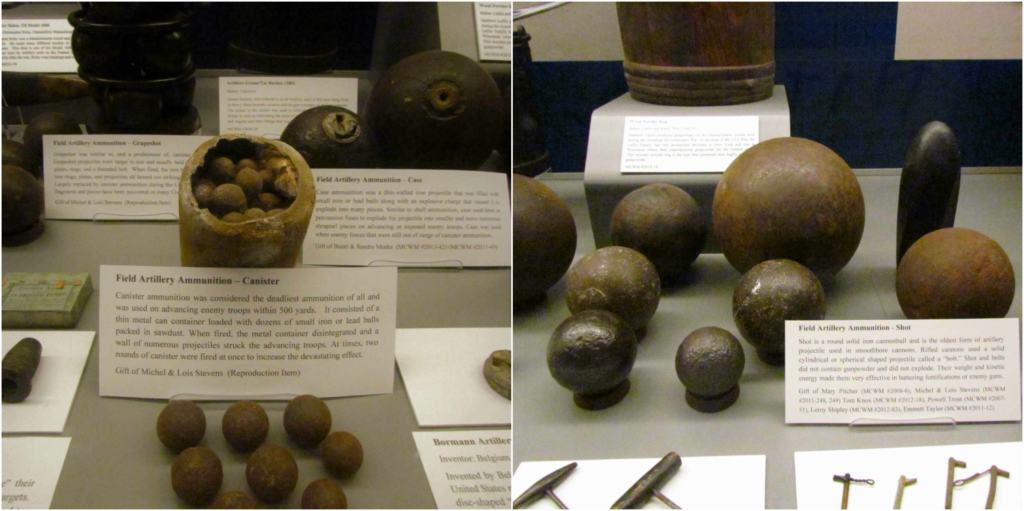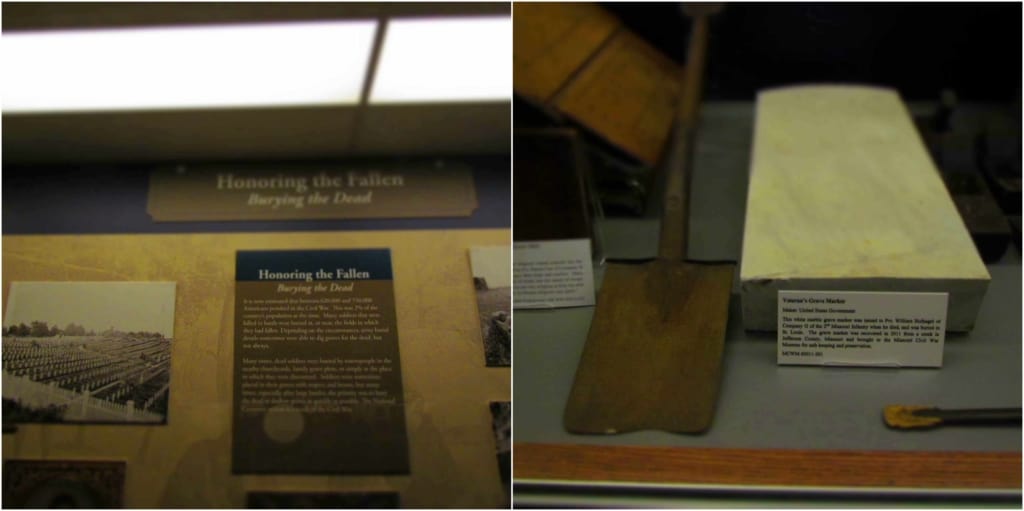When planning our visit to St, Louis, we wanted to make sure we included some stops that would help us better understand the history of the area. Jefferson Barracks happens to be the oldest operating U.S. military installation west of the Mississippi River. On these grounds, the Missouri Civil War Museum has operated since 2013. We had the chance to sit down with Mark Trout, founder and CEO, to discuss the background of the museum. His passion for preserving the historic relevance of this era is apparent. Recent times have shown a national furor about this period in America’s history. Mark explained that the museum is designed to simply preserve articles and items relating to the deadliest war ever fought on American soil.
We want to thank the Missouri Civil War Museum and Explore St. Louis for their hospitality. Rest assured that all opinions are our own.

Introductions
Upon entering the museum, the visit begins with an orientation film. Here, guests will get a base knowledge of the Jefferson Barracks, and its historical significance to St. Louis and the nation. The museum is housed in the 1905 Post Exchange and Gymnasium. Over time it has served as barracks, an overflow hospital wing, and an Infantry quarters. It fell out of use in 1946, and sat vacant for 60 years. Restoration began in 2002, and continued for 10 years. Almost all of the interior was meticulously recreated, and the museum is proud to claim no federal or state funding was required.
Throughout the building we found multiple films available. Some tell more of the general history of the area, while others focus on the events that occurred during the Civil War period. We enjoyed these, as they helped us better frame the history of the region in general. Jefferson Barracks has played an important role in the area since its founding in 1827. Named after Thomas Jefferson, the installation saw its first military action during the Black Hawk War in 1832. It has served as an induction center for many of the military events that have involved U. S. troops.

Growing Frustration
The Missouri Civil War Museum does a good job at explaining the atmosphere in the area during the period leading up to the armed conflict. Missouri was considered one of the border states, which meant that it was hotly contested by both the Union and Confederate sides. A slave state since entry into the Union, Missouri was considered on the edge of the frontier. This made the region prime for confrontation. The Mississippi River, and the port city of St. Louis, were considered vital to both sides for transportation of troops and goods. The political atmosphere of those days ensured that the region would continue to be an area of contention throughout the war.
Border War
Across the state, battles and skirmishes were ongoing. The area that would become Kansas was being contested by abolitionists and bushwhackers. (Read more about the Border War in this article>) The Missouri Civil War Museum has plenty of displays detailing the localized issues and how they reflected the national attitudes. One of the films available for viewing is about 25 minutes long and focuses specifically on Missouri’s role in the war. Plenty of comfortable seating is available in the gallery, so be sure to catch this one.

Main Gallery
On the entry level is where we found the Main Gallery. What was most certainly the area that originally held a basketball court is now home to an extensive collection of artifacts. The center section holds an open display which draws your immediate attention. The pieces are well preserved and information placards provide detailed explanations of the exhibit. All around the perimeter is a series of cases which hold smaller pieces and collections.

Ordnance
Missouri was the scene of neighbor-against-neighbor fighting during the Civil War. By the end of the war, around 140,000 Missourians will have fought on one side or the other. No portion of the state would escape the cloud of war, and it would take decades for some areas to recover. Artillery was becoming more commonplace and deadly. The museum displays a variety of styles of ordnance. We had never seen an assembled grapeshot canister before this visit. It is obviously apparent the damage that such an shell could inflict.

The Missouri Civil War Museum also displays a wide selection of personal firearms, as well. While the ever growing armies were issuing stock pieces, it was still commonplace for many soldiers to carry their own sidearms. The variety is astounding, and would have certainly caused plenty of issues in supplying the various ammunition requirements. Cartridges were just beginning to be used, so many were still armed with black powder weapons. It was interesting to see the artistic touches on the powder flasks on display.

Other Duties
Soldiers didn’t just focus on their armaments. The role of drummer was often assigned to the younger soldier. Sometimes these were merely boys who had told recruiters that they were eighteen. During a battle it would have been difficult to make out vocal commands, but the sound of the drum could carry over the ruckus. Various rolls were used to signify assembly, attack, and retreat. When not drumming, many would have served as stretcher bearers for the wounded.

Field Medicine
The drawn-out conflict created a series of medical issues for both armies. Camps were breeding grounds for illness and disease. Of the approximate 620,000 lives that were lost during the war, nearly two-thirds would be from disease. Hygiene and sanitation were not commonplace in this era. Treatments were aggressive and would often lead to death. The war would create a demand for improvements, which would become apparent towards the end. Technology quickly improved conditions in the hospitals, which were unprepared for the constant onslaught of the injured at the start of the war.

Jefferson Barracks Cemetery
With so many skirmishes and battles being fought in the region, the need for a national cemetery became quickly apparent. Even before being officially declared one in 1866, Jefferson Barracks was already the final resting place for Union and Confederate troops. The grounds began being used as a cemetery shortly after its creation in 1826. The on-site hospital, at Jefferson Barracks, would hold up to 2500 patients, but even this would be challenged at times. Steamboats anchored along the shoreline would serve as overflow hospitals. There were times during the war that Jefferson Barracks would be treating more sick and wounded than any other hospital in the nation. Many of those who passed were interred on the grounds.

The Missouri Civil War Museum has plenty of other videos to watch when you want a break from the displays. The lower level includes more exhibits, including some that span other military conflicts. Our schedule limited our available time to visit, so be sure to mark off a little more for yourself. It’s a great place to get an impartial view of a war that pitted family members against each other. We believe you will come away with a new perspective on the causes and effects of the Civil War on the region, in and around Missouri. Be sure to say Hi to Mark when you visit. He will be happy to share his passion with you.






During our 5-year RVing across America, we saw many Civil War Museums. Too bad we didn’t come across this one. Since Missouri was hotly contested during the war, it would have been very interesting.
Perhaps you will go cross country again, and then get a chance to see it.
The Missouri Civil War Museum looks like an interesting place for war buffs to explore. My husband would love it!
Be sure to plan a visit to the cemetery, as well.
Missouri is not generally top of mind in Civil War stories, but yes, it stands out for its people representing both sides of the battle. Will pin.
Thanks. We appreciate that.
I’m always interested in getting tips on good museums to visit on our travels. The Missouri Civil War Museum looks like one to put on the must-see list next time in that area. It’s sad to think that beyond the artifacts, educational information, and local cultural perspectives,etc. at the museum, it’s the cemetery that holds the most important stories (some known, many not) of those whose lives were lost.
Interesting perspective, but so true. We hope you have safe travels.
I can’t believe we missed this civil war museum when we visited St. Loius. Such an important part of our countries history.
Looks like you will need to add it to your next visit.